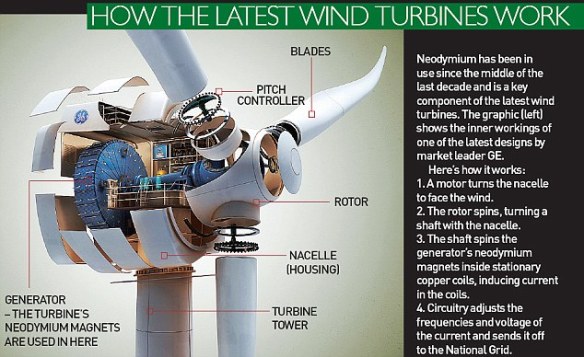- Wind turbines use blades to collect the wind’s kinetic energy.
- Wind flows over the blades creating lift (similar to the effect on airplane wings), which causes the blades to turn.
- The blades are connected to a drive shaft that turns an electric generator, which produces (generates) electricity.
- The generator?
- Electrical energy can be generated by rotating magnets inside a coil of conductive wire.
- Wind turbines use Neodymium in the magnets
Wind Turbine Cross Section
There’s a plethora of information on “why, what energy they produce, and where are they both already and proposed” of Offshore Windpower
– but what about How do they Work?
The following
- Evwind
- Iberdrola
- Oceanex
- Orsted
- Renew Economy – explains that there are 3 types:
- A spar buoy platform is a long hollow cylinder that extends downwards from the turbine tower. It floats vertically in deep water, weighted with ballast in the bottom of the cylinder to lower its center of gravity. It’s then anchored in place, but with slack lines that allow it to move with the water to avoid damage. Spar buoys have been used by the oil and gas industry for years for offshore operations.
- Semi-submersible platforms have large floating hulls that spread out from the tower, also anchored to prevent drifting. Designers have been experimenting with multiple turbines on some of these hulls.
- Tension leg platforms have smaller platforms with taut lines running straight to the floor below. These are lighter but more vulnerable to earthquakes or tsunamis because they rely more on the mooring lines and anchors for stability.
- RWE
- Wikipedia
- World Economic Forum
How far apart should wind turbines be placed? – Dr. Charles Meneveau, a researcher at Johns Hopkins University (US), developed a model to calculate the optimal spacing between turbines to obtain the best performance in large wind farms. Using large-scale computer simulations and small-scale wind tunnels for 5 MW wind turbines concluded that the optimal spacing between the turbines should be approximately 15 times the diameter of the rotor. The “Cuaderno de Aplicaciones Técnicas No. 12” titled “Wind power plants of the ABB company” indicates that the wind turbines must be located at an adequate distance between them to avoid aerodynamic interference and two other most serious consequences: the increase in turbulence and the loss of power. The optimum spacing is set between 8 and 12 times the rotor diameter in the direction of the wind, and between 2 and 4 times in the direction perpendicular to the wind. … the limitations on turbine spacing vary by territories within Spain. However, there are some common rules followed by most of them. For wind turbines on the same row, the distance among them will be of 3 times the length of the rotor diameter. In the case of turbines on different rows, the spacing among then will be of 7 times the length of the rotor diameter… (De Lucas et al. 2012). This publication also stated that the distance between turbines has increased in the last years since the newest wind turbines (3 MW machines with rotors of up to 125 m) require a larger minimum distance between adjacent turbines. Therefore, in new wind farms it is less likely that birds perceive rows of turbines as impenetrable walls. In fact, Cárcamo et al. 2011 found in Greece that the longer the distance between wind turbines, the higher is the probability that raptors will attempt to cross the space between them.
Tomorrow’s deep water Floating Wind Turbines: the six main design categories explained – Spar, Barge, Tension Leg Platform, Semi-Submersible, Combination and Hybrid – Four floating offshore wind farms have already been built, the largest of which was opened in 2023 off the coast of Norway. Two of these farms use the Hywind spar design and two use the WindFloat semi-submersible.
Before You Install Wind Energy Technology, Check Out This Database – understand where the wind blows—such as ideal landscapes for strong, consistent winds. And you will need information about the atmospheric forces that affect how wind turbines perform and how much energy they capture.
UK ocean engineering firm Tadek delivers sector-leading platform performance study for floating offshore wind – assessing through-life performance of Tension Leg Platforms (TLP) compared to Semi-Submersible alternatives for Floating Offshore Wind Turbines (FOWT)… in-depth analysis in key areas such as platform sizing, assembly and fabrication arrangements, quayside and port operarions, tow and stability, mooring and cable installations, mooring hook up and operation performance. Moreover, the report meticulously examined the benefits and drawbacks associated with both SemiSub’s and MPS’ PelaFlex TLP system across various stages of operation.
And there are YouTube clips eg

